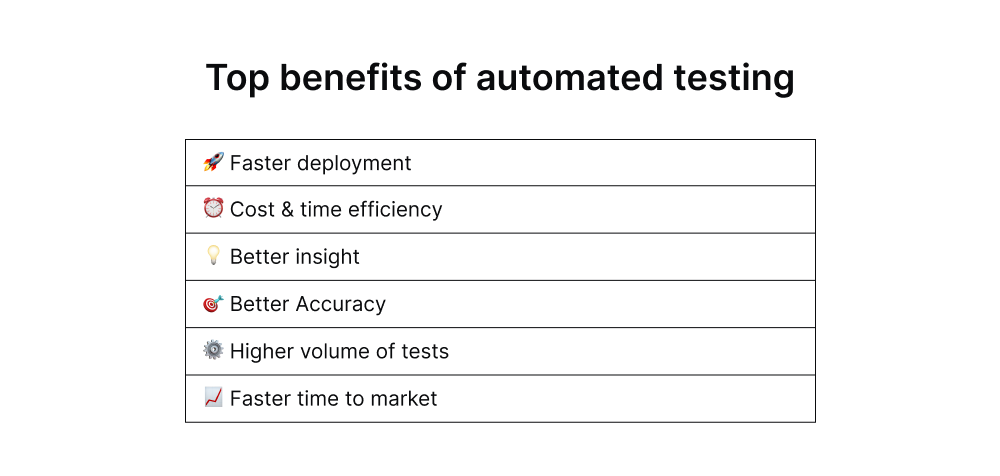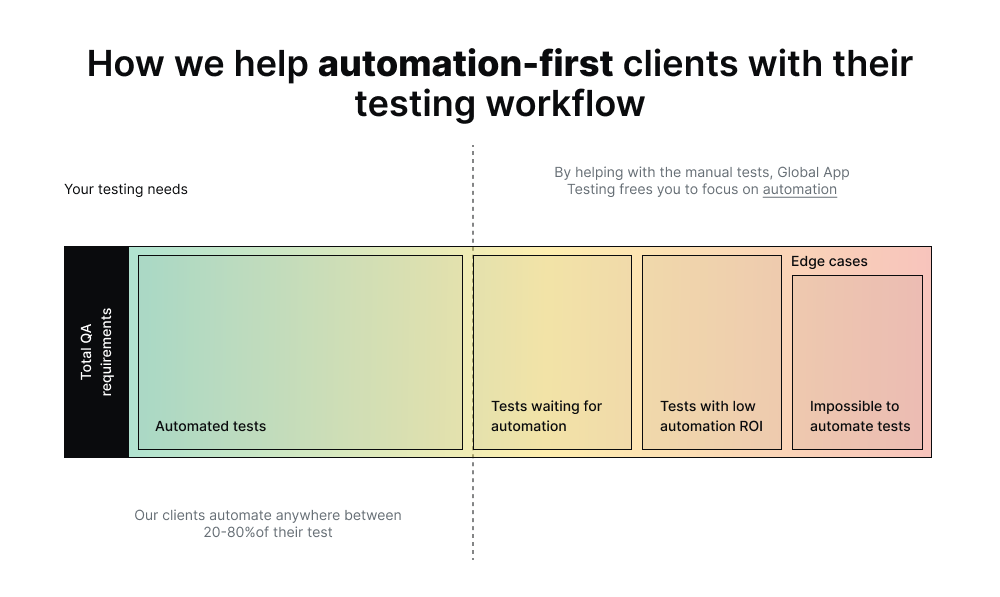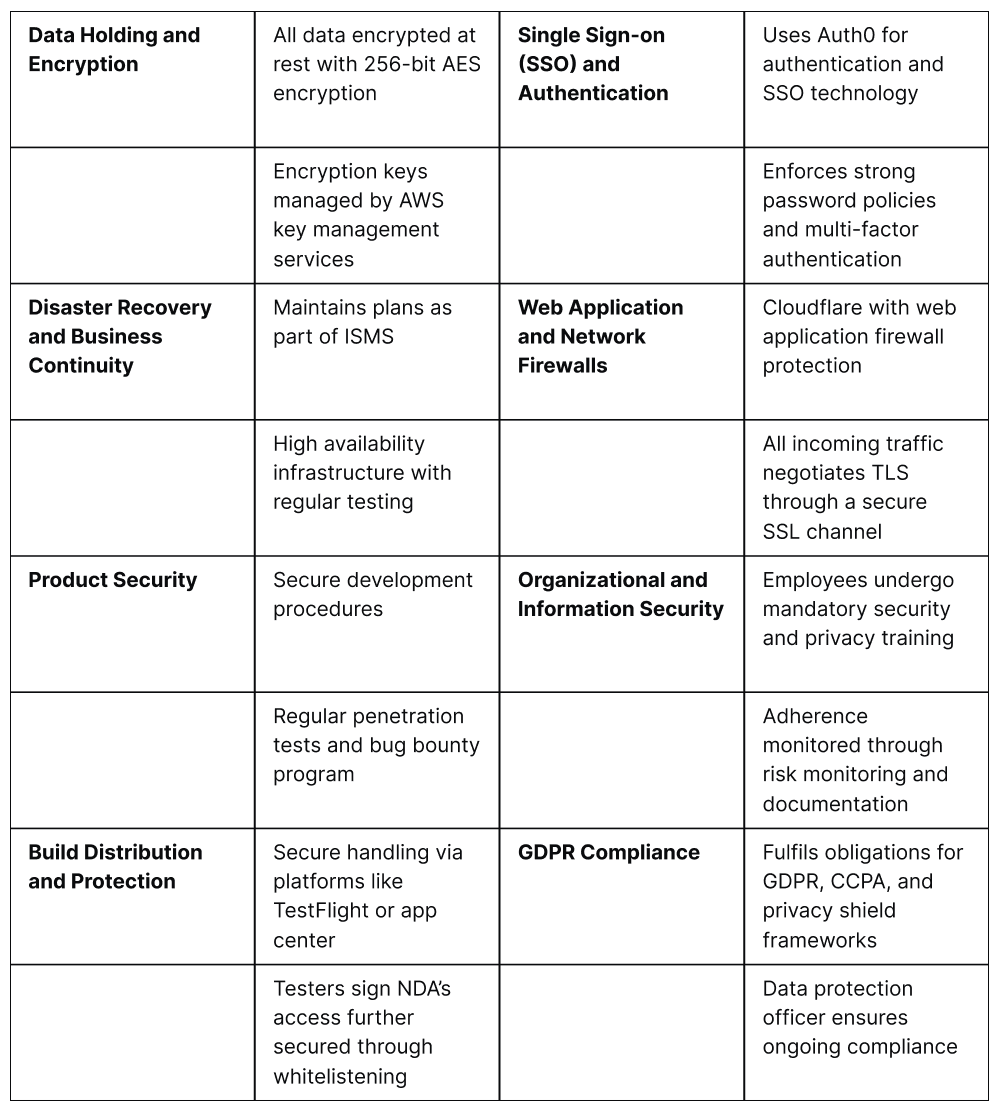Top 17 challenges in QA testing to overcome in 2025 [Solved]
Did you know that 45% of organizations have a dedicated quality assurance (QA) budget?
The testing market is projected to expand through 2030, driven by the increasing demand for various forms of testing due to the emphasis on cybersecurity and risk compliance. Particularly, websites and mobile apps require rapid, efficient, and effective testing. However, QA teams and testers encounter challenges mainly tied to the cost, speed, and scalability of their testing endeavors.
So, in this article, we'll uncover the top 17 challenges in QA testing and provide practical solutions to help you boost the effectiveness of QA practices. Let's begin!
We can help you overcome QA testing challenges aligned with your business goals
17 challenges in QA testing and how to solve them
Navigating the terrain of software testing can be tricky, but it doesn't need to be an uphill battle. Uncover the top 17 challenges in QA testing that software testers face and discover practical strategies to conquer them easily.
1. The "one size fits all" approach
Using the same tests for all software, regardless of its unique needs, is a common mistake.
Those can leave out specific user requirements, causing incomplete testing. When checking a software product, it's vital to consider what end-users need. Ignoring these details might mean important issues are overlooked, impacting user experience.
For instance, if testing a teacher scheduling app only looks at basic features without considering the specific needs of teachers and students, it might not fully meet their requirements.
Solution
To overcome this kind of challenge, use a more personalized testing method that matches your ICP's needs. Grasp what the end-users want, research it, and create test scenarios that mirror real-life situations and user actions. This way, the testing process is adjusted to match how the software is meant to be used.
2. Lack of skilled workforce or experience
Finding skilled software testers is tough due to high demand and competition. A proficient testing team is crucial for spotting and fixing defects effectively. Without experienced testers, the risk of missing critical issues increases, causing delays, financial losses, and compromising product quality. This shortage significantly impacts project timelines and budgets.
Solution
Invest in building and retaining a skilled testing team to tackle this hurdle. This might mean providing training and development opportunities for existing staff, attracting experienced testers, and creating a work environment that encourages expertise and innovation. Collaborating with educational institutions and certification programs can also be beneficial for nurturing talent.
Pro tip
However, if you don’t feel like investing a large sum of money into ongoing employee training, consider using the Global App Testing solutions. With over 90,000 available testers, you can easily choose ones that fit your needs and get educated testers within your niche. Even if your product is not something of broad usage and you require specific knowledge, Global App ensures that you are set up for successful testing to achieve your commercial goals.
3. Stringent time constraints
Time is a critical challenge in software testing, primarily due to two main factors:
- The inherent time requirements for comprehensive testing.
- Organizations tend to prioritize new feature development over testing and maintenance.
Thorough testing takes time, particularly for complex software. Additionally, organizations often allocate more resources to developing new features, as these offer a more immediate return on investment rather than investing in improving existing ones.
QA teams frequently encounter tight deadlines due to extended development phases and underestimation of testing time requirements. Rushing through the testing phase can lead to incomplete coverage, missed bugs, and subpar product quality.
Solution
To handle time constraints better, use smart time management and allocate resources wisely. To conquer this hurdle, consider aligning the software with core business specifications, especially when time is tight. For example, adopt continuous integration and continuous testing, automate repetitive tests, and ensure testing is part of the development process.
Stressing the importance of testing in project success helps prioritize it with feature development. Kick-off testing a minimum of three days before the release date, creating room for thorough verification and debugging. This approach guarantees that the software meets the required quality standards.
4. Lack of automated tasks in testing
Completely manual testing can waste a lot of time and resources, especially with complex applications. First, you need to find testers, which is the most difficult task. Then, testers need to explore numerous scenarios, data combos, and user interactions, making it a laborious process.
They have to go step by step, checking different paths, inputs, and interactions in the application. This way, it becomes a bottleneck, especially for applications with extensive features. Completely manual testing is also prone to human error and might not ensure consistent testing across multiple iterations.
Solution
Automating testing tasks, or at least part of them, can supercharge your testing process by boosting efficiency and effectiveness. Testers can automate repetitive test cases by creating and running test scripts, slashing time and effort.

This method ensures thorough test coverage, faster execution, and consistent results. Using test case management tools takes it a step further, streamlining the process and allowing testers to track and manage tests easily.
Pro tip
Do you have software tests waiting to be automated? Our crowd enhances and supports your automation process:
- Quickly expand your manual testing team to release automation engineers.
- Parallel testing matches the speed of automation.
- Receive results within 6 hours.
- Access crowd-testing 24/7.
- Benefit from test plan consultancy and test case creation.
- Utilize manual testing for aspects that can't be automated.
- Seamlessly integrate with your existing tech stack.
- Scale with minimal effort for maintenance.

Whether you're initiating automation, enhancing existing processes, or exploring alternative solutions, Global App Testing provides a valuable solution for achieving the highest quality.
5. Lack of communication between developers and testers
Many times, people underestimate the importance of effective communication between developers and testers, causing misunderstandings and reduced product quality. Developers and testers usually operate in their own worlds, needing to collaborate more. This lack of communication can lead to testers missing crucial updates or code changes.
At the same time, developers might not grasp testing priorities and requirements. Thus, it results in overlooked bugs and lower product quality.

Solution
To conquer this challenge, establish a strong communication system during development. It involves creating a Quality Assurance (QA) framework that promotes ongoing collaboration and information sharing between developers and testers. Regular meetings, proper documentation, and a shared understanding of the project's objectives facilitate effective communication.
When developers and testers work together as a unified team, they ensure alignment toward the shared goal of delivering a high-quality product.
Develop a high-quality product by incorporating application testing aligned with your business goals
6. Unstable environment
QA teams often face instability in the testing environment, leading to server crashes and the need for frequent restarts during testing.
This instability hampers the testing process, resulting in delayed timelines and compromised test results.
Solution
To address this challenge, promptly escalate these issues to senior team members and ensure the testing environment is stabilized and prepared for testing. For example, it might involve optimizing server resources, monitoring performance, and implementing measures to prevent overloads.
7. Imposed tool usage
At times, QA teams are forced to use particular tools unsuitable for the project due to existing licenses held by clients or organizations.
This constraint can obstruct the testing process and undermine the effectiveness of testing tools.
Which usually results in many bugs within your software and non-satisfied users.
Solution
When faced with this situation, it's an opportunity to explore alternative tools or strategies. Evaluate the effectiveness of these tools and consider how you can adapt them to align better with the project's requirements. Additionally, communicate with clients or organizations to explore potential tool replacements upon license expiration.
8. Utilizing third-party testing documents
Test cases crafted by external parties might be less efficient, elongating the verification process and restricting defect discovery. Depending on third-party documentation might not closely match the project's specific requirements and functionality.
Solution
Consider investing the time and effort to create testing documentation from scratch. This approach ensures that test cases align closely with the project's requirements and functionality, streamlining the verification process.
9. Friday software releases
The anticipation of successful Friday releases conflicts with the practical experience that software typically requires multiple release attempts. Releasing software on Fridays may limit the time available for addressing unexpected issues.
Solution
Optimal release timing is at the beginning of the week, allowing both development and QA teams the rest of the week to address any unexpected issues that may arise.
This approach provides a buffer for resolving problems and ensures a smoother release process.
10. Unpredictable testing estimations
Despite efforts to provide accurate testing time estimates, unpredictability can lead to estimation inaccuracies. Unexpected challenges during testing may extend timelines, impacting project schedules.
Solution
To manage this challenge, maintain transparency about the potential for estimation variations. Emphasize adaptability and the ability to adjust timelines when unforeseen testing challenges emerge, fostering realistic expectations.
11. Simultaneous testing and bug fixes
Collaboration between developers and QA engineers is vital, but the simultaneous need for testing and bug fixing can be challenging. These changes may introduce uncertainties and require additional testing cycles.
Solution
Ensure a well-coordinated workflow where testing commences once a portion of the development process is complete. You can follow it with a structured bug-fixing process, allowing for efficient identification and resolution of QA-reported defects.
12. Last-minute requirement changes
Agile development projects often involve last-minute changes to project requirements, impacting testing efforts and schedules. This can cause many bugs within your software, breaking your update or launch and leaving users unsatisfied.
Solution
To overcome this challenge, ensure to maintain flexibility and readiness to adapt to evolving requirements. Develop a systematic approach to reevaluate and test affected areas, ensuring stability and compatibility with existing code.
13. Test data management challenges
Ensuring accurate and varied test data is available for comprehensive testing poses a frequent challenge. Insufficient or unrealistic test data can result in incomplete testing coverage and the neglect of critical scenarios.
Solution
Put in place a strong test data management strategy by ensuring a variety of datasets accurately mirror real-world scenarios. For instance, crafting data subsets, anonymizing sensitive information, and regularly updating datasets to meet evolving application requirements.
14. Inadequate documentation
A lack of thorough documentation can slow down the testing process, causing misunderstandings, overlooking test scenarios, and making it challenging to reproduce defects. Incomplete or outdated documentation can be a hindrance to both testing and development activities.
Solution
Emphasize thorough documentation throughout the software development lifecycle. Document test cases, requirements, and test scenarios comprehensively. Regularly update the documentation to align with changes in the application, ensuring clarity and facilitating effective communication.
15. Limited accessibility testing
Overlooking accessibility testing can result in software that is not inclusive and may exclude users with disabilities. Ignoring accessibility standards can lead to legal and reputational issues.
Solution
Integrate accessibility testing into the QA process to ensure software meets accessibility standards. Use tools to identify and rectify accessibility issues and involve users with diverse abilities in testing to gather valuable feedback.
Why are Accessibility tests valuable?
- Inclusivity: Accessibility tests guarantee that a company's products or services are accessible to all users, including those with disabilities.
- Legal compliance: Many countries mandate companies to ensure their products and services are accessible to people with disabilities.
- Business growth: Ensuring accessibility expands the company's audience, including people with disabilities, potentially gaining loyal customers.
- Brand image: Companies prioritizing accessibility showcase their commitment to social responsibility and inclusivity.
- Innovation: Prioritizing accessibility can foster innovation and creativity in product development.
Accessibility testing can be conducted manually or with automated testing tools. It's crucial to incorporate accessibility testing throughout the product development lifecycle—from design to implementation to deployment—to ensure inclusivity for everyone, including those with disabilities.
- Visual impairments: Assessing compatibility with screen readers, color contrast ratios, and other visual accessibility features.
- Auditory impairments: Evaluating compatibility with captioning, audio descriptions, and other auditory accessibility features.
- Motor impairments: Examining compatibility with assistive technologies like voice recognition software and keyboard-only navigation.
- Cognitive impairments: Testing compatibility with readability, simplification, and other cognitive accessibility features.
- Web accessibility: Verifying compatibility with web accessibility standards, such as WCAG 2.1, for web-based products or services.
16. Insufficient security testing
Inadequate security testing exposes software to vulnerabilities that malicious entities can exploit. Failing to identify and address security issues during testing can have severe consequences post-deployment.
Solution
Prioritize security testing to identify and address vulnerabilities early in the development process. Conduct penetration testing, code reviews, and security scans to fortify the software against potential threats.
Pro Tip
Security is a paramount concern at Global App Testing, and we prioritize safeguarding your data and software. With ISO 27001 certification, we meet the highest global security standards, and we developed robust processes and policies to ensure data security, integrity, and availability.

17. Resistance to change
Resistance to adopting new testing methodologies, tools, or practices can be a roadblock to progress. Additionally, team members hesitating to embrace changes may result in a stagnant testing environment.
Solution
Foster a culture of continuous improvement by promoting the benefits of new methodologies and tools. Provide training and support to ease the transition and encourage open communication to address concerns and build a collaborative testing environment.
Conclusion
Tackling challenges in QA testing makes the job of QA testers easier and streamlines the entire software development process, boosting efficiency. Simplifying the tasks of QA professionals ensures products meet business requirements and function optimally, ultimately contributing to overall organizational success. Keep in mind that testing isn't merely a stage in development but an ongoing commitment to guarantee the dependability, functionality, and security of web applications.
Embrace these suggestions, leveraging the combined expertise of QA and development teams to bolster your testing endeavors and propel the triumph of your applications. Need web application testing for your project? Collaborate with Global App Testing experts to ensure success.
Reach out to discover more about our testing services and how we can ensure your application meets all quality requirements.
Get started with application testing aligned with your business goals
FAQ
How does a tailored testing approach address challenges?
Switching to a personalized testing approach means grasping user needs, researching, and creating test cases that mirror real-world situations. Also, it prevents the drawbacks of a one-size-fits-all testing strategy.
What strategies can mitigate time constraints in QA testing?
To beat time constraints, adopt efficient time management and continuous integration, and give testing equal priority with feature development.
Why is effective communication important in QA testing?
Effective communication between developers and testers is vital to prevent misunderstandings, misalignment, and reduced product quality. It fosters collaboration, ensuring everyone is aligned toward delivering a high-quality product.
How do challenges in QA testing impact the software development process?
Proactively addressing challenges is crucial for efficient software development, preventing delayed timelines, compromised product quality, and increased financial costs.
Keep Learning
3 Alternatives to Hiring Internal QA
Is Crowd Testing Just Outsourcing?
Help! I Can't Recreate My Customer's Bugs

